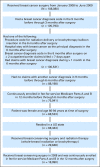Patterns of use and short-term complications of breast brachytherapy in the national medicare population from 2008-2009
- PMID: 23091103
- PMCID: PMC3675700
- DOI: 10.1200/JCO.2012.43.5297
Patterns of use and short-term complications of breast brachytherapy in the national medicare population from 2008-2009
Abstract
Purpose: Brachytherapy has disseminated into clinical practice as an alternative to whole-breast irradiation (WBI) for early-stage breast cancer; however, current national treatment patterns and associated complications remain unknown.
Patients and methods: We constructed a national sample of Medicare beneficiaries ages 66 to 94 years who underwent breast-conserving surgery from 2008 to 2009 and were treated with brachytherapy or WBI. We used hospital referral regions (HRRs) to assess national treatment variation and an instrumental variable analysis to compare complication rates between treatment groups, adjusting for patient and clinical characteristics. We compared overall, wound and skin, and deep-tissue and bone complications between brachytherapy and WBI at 1 year of follow-up.
Results: Of 29,648 women in our sample, 4,671 (15.8%) received brachytherapy. The percent of patients receiving brachytherapy varied substantially across HRRs, ranging from 0% to over 70% (interquartile range, 7.5% to 23.3%). Of women treated with brachytherapy, 34.3% had a complication compared with 27.3% of women undergoing WBI (P < .001). After adjusting for patient and clinical characteristics, 35.2% of women treated with brachytherapy (95% CI, 28.6 to 41.9) had a complication compared with 18.4% treated with WBI (95% CI, 15.5 to 21.3; P value for difference, <.001). Brachytherapy was associated with a 16.9% higher rate of wound and skin complications compared with WBI (95% CI, 10.0 to 23.9; P < .001), but there was no difference in deep-tissue and bone complications.
Conclusion: Brachytherapy is commonly used among Medicare beneficiaries and varies substantially across regions. After 1 year, wound and skin complications were significantly higher among women receiving brachytherapy compared with those receiving WBI.
Conflict of interest statement
Authors' disclosures of potential conflicts of interest and author contributions are found at the end of this article.
Figures
Comment in
-
When hope hinders science and patient-centered care.J Clin Oncol. 2012 Dec 10;30(35):4283-4. doi: 10.1200/JCO.2012.45.4660. Epub 2012 Oct 22. J Clin Oncol. 2012. PMID: 23091102 No abstract available.
-
When retrospective comparative effectiveness research hinders science and patient-centered care.J Clin Oncol. 2013 Jun 10;31(17):2226-7. doi: 10.1200/JCO.2012.47.6911. Epub 2013 May 13. J Clin Oncol. 2013. PMID: 23669221 No abstract available.
-
Reply to L.W. Cuttino et al.J Clin Oncol. 2013 Jun 10;31(17):2227-9. doi: 10.1200/JCO.2013.49.0441. J Clin Oncol. 2013. PMID: 23901421 No abstract available.
-
[Evaluation of (balloon) brachytherapy for partial breast irradiation in breast cancer based on current meta-analyses].Strahlenther Onkol. 2013 Oct;189(10):899-901. doi: 10.1007/s00066-013-0425-z. Strahlenther Onkol. 2013. PMID: 23963208 German. No abstract available.
Similar articles
-
Association between treatment with brachytherapy vs whole-breast irradiation and subsequent mastectomy, complications, and survival among older women with invasive breast cancer.JAMA. 2012 May 2;307(17):1827-37. doi: 10.1001/jama.2012.3481. JAMA. 2012. PMID: 22550197 Free PMC article.
-
Accelerated partial breast irradiation for elderly women with early breast cancer: A compromise between whole breast irradiation and omission of radiotherapy.Brachytherapy. 2017 Sep-Oct;16(5):929-934. doi: 10.1016/j.brachy.2017.06.006. Epub 2017 Jul 8. Brachytherapy. 2017. PMID: 28697858 Clinical Trial.
-
Late side-effects and cosmetic results of accelerated partial breast irradiation with interstitial brachytherapy versus whole-breast irradiation after breast-conserving surgery for low-risk invasive and in-situ carcinoma of the female breast: 5-year results of a randomised, controlled, phase 3 trial.Lancet Oncol. 2017 Feb;18(2):259-268. doi: 10.1016/S1470-2045(17)30011-6. Epub 2017 Jan 14. Lancet Oncol. 2017. PMID: 28094198 Clinical Trial.
-
Partial-breast treatment for early breast cancer: emergence of a new paradigm.Nat Clin Pract Oncol. 2005 Jan;2(1):40-7. doi: 10.1038/ncponc0071. Nat Clin Pract Oncol. 2005. PMID: 16264855 Review.
-
Outcomes with Partial Breast Irradiation vs. Whole Breast Irradiation: a Meta-Analysis.Ann Surg Oncol. 2021 Sep;28(9):4985-4994. doi: 10.1245/s10434-020-09447-w. Epub 2021 Jan 3. Ann Surg Oncol. 2021. PMID: 33393051
Cited by
-
Stereotactic partial breast irradiation in primary breast cancer: A comprehensive review of the current status and future directions.Front Oncol. 2022 Oct 13;12:953810. doi: 10.3389/fonc.2022.953810. eCollection 2022. Front Oncol. 2022. PMID: 36313648 Free PMC article.
-
New Breast Cancer Radiotherapy Technology Confers Higher Complications and Costs Before Effectiveness Proven: A Medicare Data Analysis.Inquiry. 2018 Jan-Dec;55:46958018759115. doi: 10.1177/0046958018759115. Inquiry. 2018. PMID: 29502466 Free PMC article.
-
Response.J Natl Cancer Inst. 2014 Aug 11;106(9):dju198. doi: 10.1093/jnci/dju198. Print 2014 Sep. J Natl Cancer Inst. 2014. PMID: 25114276 Free PMC article. No abstract available.
-
Long term radiographic findings of breast brachytherapy: Implications of surgical volume.J Surg Oncol. 2017 Aug;116(2):203-207. doi: 10.1002/jso.24646. Epub 2017 Apr 26. J Surg Oncol. 2017. PMID: 28445590 Free PMC article.
-
Persistent Use of Extended Fractionation Palliative Radiotherapy for Medicare Beneficiaries With Metastatic Breast Cancer, 2011 to 2014.Am J Clin Oncol. 2019 Jun;42(6):493-499. doi: 10.1097/COC.0000000000000548. Am J Clin Oncol. 2019. PMID: 31033511 Free PMC article.
References
-
- NIH consensus conference: Treatment of early-stage breast cancer. JAMA. 1991;265:391–395. - PubMed
-
- Vaidya JS, Joseph DJ, Tobias JS, et al. Targeted intraoperative radiotherapy versus whole breast radiotherapy for breast cancer (TARGIT-A trial): An international, prospective, randomised, non-inferiority phase 3 trial. Lancet. 2010;376:91–102. - PubMed
-
- Bartelink H, Horiot JC, Poortmans P, et al. Recurrence rates after treatment of breast cancer with standard radiotherapy with or without additional radiation. N Engl J Med. 2001;345:1378–1387. - PubMed
-
- Abbott AM, Habermann EB, Tuttle TM. Trends in the use of implantable accelerated partial breast irradiation therapy for early stage breast cancer in the United States. Cancer. 2011;117:3305–3310. - PubMed
Publication types
MeSH terms
Grants and funding
LinkOut - more resources
Full Text Sources
Medical



